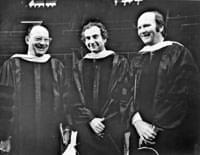Bardeen, Cooper and Schrieffer (left to right)
In 1911, Heike Kamerlingh Onnes, in his quest to study materials at ever lower temperatures, happened to find that the electrical resistance of some metallic materials suddenly vanished at temperatures near absolute zero. He called the phenomenon superconductivity, and scientists soon found additional materials that exhibited this property.
But no one could completely explain how it worked. For the next few decades, many prominent physicists worked to develop a theory of the mechanism underlying superconductivity, but no one had much success, and some despaired of figuring it out. One such physicist, Felix Bloch, was quoted as proposing “Bloch’s theorem: Superconductivity is impossible.”









Comments are closed.